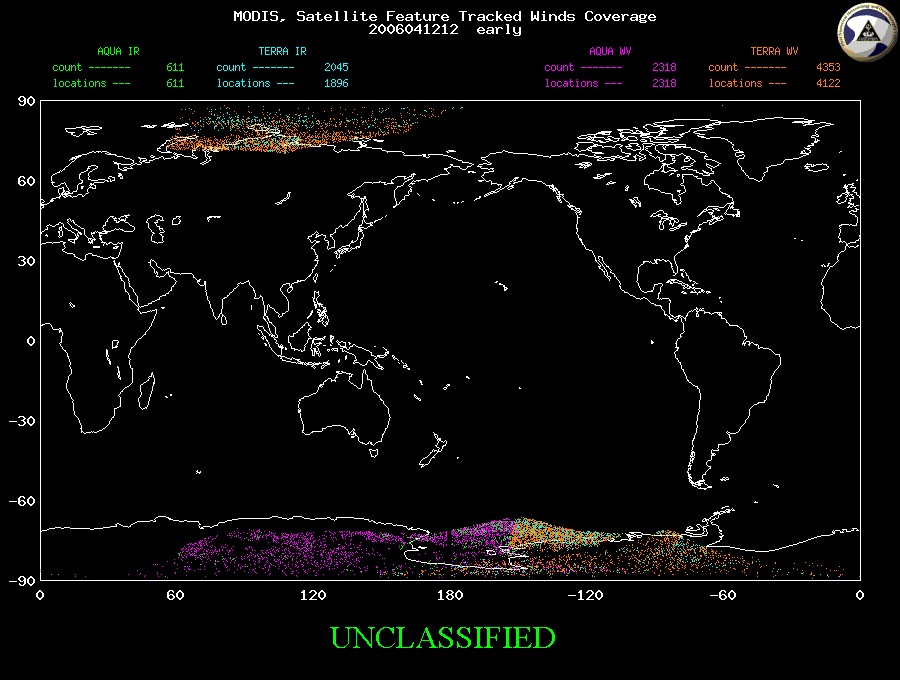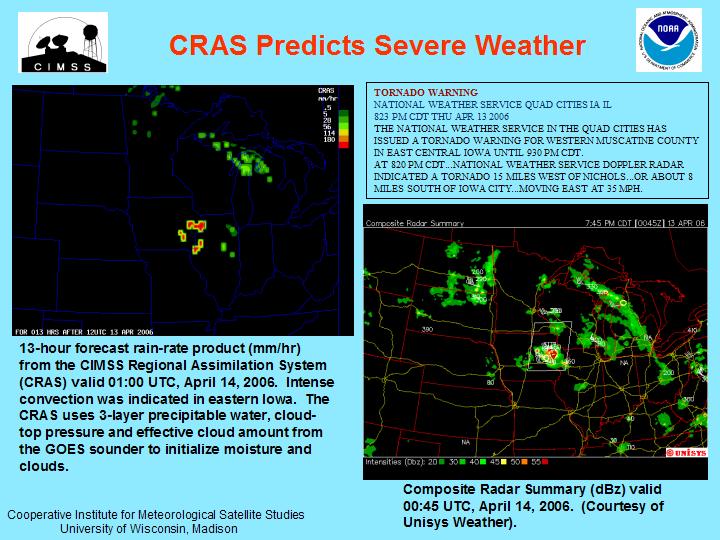
[ Archive ]

 |
CIMSS-NOAA Weekly Report
[ Archive ] |
 |
IN THE PRESS:
ITEMS FOR THE ADMINISTRATOR:
ITEMS FOR THE ASSISTANT ADMINISTRATOR:
Operational Assimilation of Direct Broadcast MODIS Winds at U.S. Navy: In mid-March, 2006, the Fleet Numerical Meteorology and Oceangraphy Center (FNMOC, U.S. Navy) began operational use of the Moderate Resolution Imaging Spectroradiometer (MODIS) polar winds that are generated on-site in McMurdo, Antarctica. In mid-April, FNMOC began operational use of MODIS winds generated on-site in Tromsø, Norway. The McMurdo polar winds system uses MODIS data collected by the National Science Foundation's direct broadcast (DB) system. The Tromsø winds use data collected by an Integrated Program Office antenna on Svalbard. FNMOC is using the winds in NOGAPS (Navy Operational Global Atmospheric Prediction System), where the DB winds are "superobbed" together with the previously operational “bent-pipe” MODIS winds (MODIS data obtained through a NASA data center). However, the DB winds are available sooner, allowing for significantly more wind data to enter into the early model runs. Other weather prediction centers are expected to use the DB winds operationally after a consensus is reached on distribution methods. Additional DB sites in the Arctic and Antarctic are being considered. (J. Key, E/RA2, 608-263-2605, jeff.key@noaa.gov, W. Straka III, CIMSS, D. Santek, CIMSS, C. Velden, CIMSS, M. Lazzara, SSEC, R. Pauley, FNMOC)Significance:
Eight numerical weather prediction centers in five countries have
demonstrated that the MODIS polar winds have a positive impact on
weather forecasts not only within the polar regions, but also in the
extratropics. These centers use the conventional
MODIS winds in the global runs of their operational forecast
systems. The introduction of the direct broadcast MODIS winds
makes it possible to include more high latitude data in early forecast
model runs.
NOAA Mission Goal:
Serve society's needs for weather and water information.
NOAA Cross-Cutting Priorities:
Sound, Reliable State-of-the-Art Research
 (Click image to enlarge)
(Click image to enlarge)
Figure caption: Availability of MODIS polar wind data for the early forecast run on April 4, 2006 at 12 UTC at Fleet Numerical Meteorology and Oceangraphy Center. The only MODIS wind data available for this run were from the direct broadcast sites at McMurdo, Antarctica, and Tromsø, Norway.
ITEMS FOR THE OFFICE DIRECTOR, STAR:
Ackerman to Serve on Cooperative Institute Executive Committee: Steve Ackerman, Director of the Cooperative Institute for Meteorological Satellite Studies (CIMSS), has been selected to be the NESDIS representative for the Cooperative Institute Executive Committee. (S. Ackerman, CIMSS, 608-263-3647) (Click
image to enlarge)
(Click
image to enlarge)